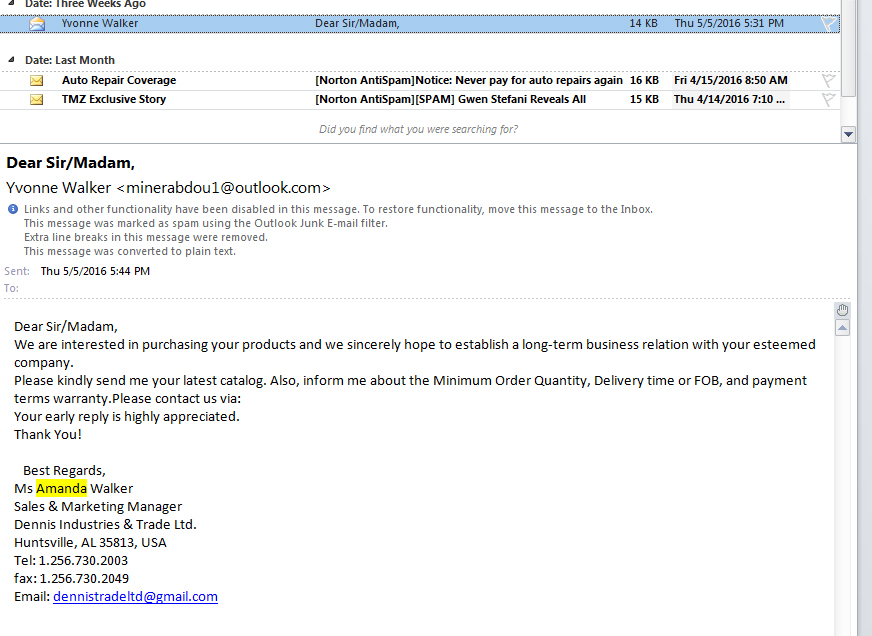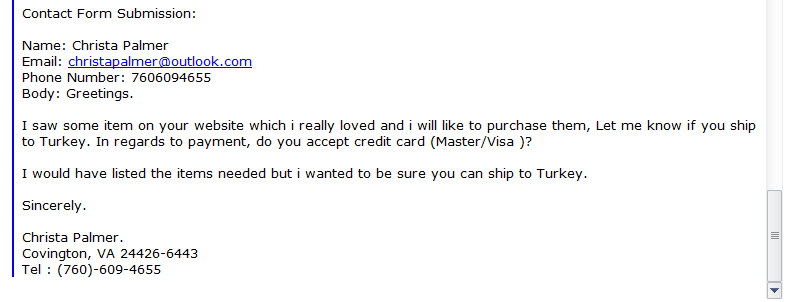 An ABC News report in April said the average person receives 500 pieces of junk e-mail every year. Well I must be getting the junk email slated for everyone in the world who doesn’t have a computer, tablet, or cell phone because I get about 500 a day. Okay, some of them are a result of my ridiculous habit of online shopping from sites that offer a good deal (“join our newsletter list for 10% off your first order), but others are true junk, which can not only be annoying, they can be malicious if opened.
An ABC News report in April said the average person receives 500 pieces of junk e-mail every year. Well I must be getting the junk email slated for everyone in the world who doesn’t have a computer, tablet, or cell phone because I get about 500 a day. Okay, some of them are a result of my ridiculous habit of online shopping from sites that offer a good deal (“join our newsletter list for 10% off your first order), but others are true junk, which can not only be annoying, they can be malicious if opened.
More time consuming (and potentially more dangerous) are the tantalizing emails from “prospective customers” that once engaged, can cost the business a lot of money. I like to consider myself as an expert in identifying these, but even 14 years into this, I can still be fooled. Because who doesn’t want to fill a large order?
I’ve come to the realization that I can spend an inordinate number of hours pressing the delete button, deciding if the email is real and I should open the .zip attachment, deciding if I really need to buy a pair of shoes because I have a 10% off coupon, OR, I can do some strategic activities to not get the emails in the first place or to get them out of my inbox before I see them. While this helps with the volume of spam, as a business you will still need to determine what to do with those lucrative offers.
Why Me?
If I wasn’t fairly confident in my evaluation of self, I’d be pretty sure that I’m a target for the evil spammers worldwide. But I do know a few reasons for the glut of spam:
- I receive the emails for the “info” followed by the URL (globalcrafts.org), which spammers expect to exist and be read
- I drew the short straw and my inbox is the recipient of all emails that have the URL of globalcrafts.org, if it doesn’t have one of the five other users’ name before the “@” sign.
- My email address is the one that is published on most websites we manage.
- My email address receives all of the emails generated from our Contact Us pages.
- Did I mention I join newsletters regularly because I’m addicted to online shopping?
It’s not personal, and that’s the problem. So let’s get rid of the easy junk first.
Keeping Junk from Getting Into Your Inbox
Here are a few easy things you can do to eliminate junk before it even get in front of your eyes:
Set Up Rules
Most email systems offer the ability to set up rules that direct your emails to another recipient (I like to share the wealth…), another folder, including the Junk folder, or automatically delete it. If you do this, give your Junk folder a cursory view every now and then before emptying it into the Deleted folder (I just found two invoices there – it’s almost as good of excuse as the dog ate my homework…)
I am hesitant to Block Senders as many spam emails use senders that they grabbed from your email lists (a whole other topic). One spammer that’s nagging me now tempted me to block him until I saw the email address was mine! I set up a rule that automatically deletes emails from the Name, not the email address. I realized his emails are generated through our Contact Us page.
Unsubscribe
I’m certainly not one who should be telling you to Unsubscribe from an email newsletter considering that sending an email newsletter is one of Global Crafts’ best marketing tools. But realize that many of the large online companies sell your email address to others and pretty soon your Inbox is overrun with unsolicited offers. And then there are the fake emails that clicking the Unsubscribe button just lets them know you are a real person so they just send you more. So I suggest you unsubscribe from the big companies unless you’re in the market for something that they carry.
Remove Email Addresses from Websites
Some spammers “scrape” web pages for email addresses, taking any data with an “@” sign as a potential spammee. I’m sure you’ve noticed web pages with the word “at” in place of the “@” sign in an attempt to foil the spammers. Alternatively, many web pages have “Contact Us” pages with no email addresses, just a form that generates an email behind the scenes.
While both of these methods may minimize the number of spam emails you receive, you may be creating barriers for people who have a valid reason to email you. Personally, I prefer clicking on an email link rather than a form (while we have a form on Global Crafts, we also have the “info” email address – I receive both.)
Success Has its Downsides – Scam Emails
I’ve done what I can to automatically remove emails from my inbox (and also have a very agile Delete Key finger) but I haven’t found a way to automatically delete scams other than just getting familiar with their format and making an educated judgement call.
Those of you who have an ecommerce website have probably received emails that appear too good to be true. I hate to be the bearer of bad news but – in most cases – they are. And I wish I could tell you they were all scams but then there will be that one that could have made you a millionaire so this advice does not come with any guarantees.
Here’s a sample email (of one of the 20 I’ve had today)
Seven Things Wrong with this Email
Okay, I would delete this from the subject, but I’m probably a little more callous than most. Here are just a few more tipoffs that this is from a scammer:
- The email address doesn’t match the email address in the contact information
- The name of the sender is Yvonne and the contact information is Amanda
- They are requesting information that is readily available on the website
- “Delivery Time or FOB” as a choice makes no sense (one is time and the other is price). They’re just stringing together terms about purchasing
- The closest company I could find in Google was in New Zealand
- The subject makes no sense
- There’s no indication of the types of products they are looking for
The formats for these emails are surprisingly similar since they are originating from countries around the world. It’s almost as if there’s a class for writing scam emails.
The email below is short and sweet and more typical:
This is a more common format for the scam emails. We do ship overseas so it’s not inconceivable that someone in another country would contact us. But please don’t tell scammers that there is no one named “Sales.” The typical scammer email also wants to know if we export to [fill in some exotic country], and take credit cards. The updated class on writing scam emails has the question, “Do you allow private pickup or pick-up by freight forwarders?” I’m guessing this is because many ecommerce websites said they don’t export.
What Happens If you Engage?
If you reply to these emails, Standard Scammer Operating Procedure is to actually visit the website for the first time – remember, they’re often working off your email address so they may have your site from that but I’ve had many scammers actually ask me for my website. They choose the most expensive items and often large quantities and send you an “order” by email. Things can go in a variety of directions if you suggest that you can fill the order but trust me, somewhere in the scenario you will be asked to send money or product.
What Happens If you Don’t?
The email below is the response when one of our customers who has a Shopify site that we manage engaged. The original email is below. I have to admit, it was one of the better-written scam emails and I may have been tempted to reply. The original contact was through a Contact Us page on the site. But the reply has some significant clues to its scamminess.
And here’s the original:
The majority of the “tells” were in the response rather than the original email:
- They shopped by categories and selected the most expensive items
- They instruct me to call UPS or DHL for a shipping quote
- They offer to arrange shipping (I’m sure it would be through a freight forwarder)
- They didn’t place the order online
This would have been a $400-$500 retail order but I’m confident it would have cost us more had we continued to engage.
I Wish I Had SPAMDAR
I could spout all of those advice metaphors – hindsight is 20/20, if it seems too good to be true, it is, there’s a sucker born every minute –but I know these don’t help me make decisions when I see something shiny in my Inbox. Just this year we responded to a request for products to be included in a feature for “The List” and “In Style” magazine wanted to purchase a large volume of product for a giveaway. “The List” request cost some product and shipping and to be fair, the woman did do a SKYPE interview, which is a lot of work on her part for some free recycled bags but nothing was published (and no response to my email after the interview.) The “In Style” request cost us a lot of time but no actual products — I’m sure you’ve had the celebrity swag bag requests, which I now ignore. Will I engage with these kinds of requests in the future? Absolutely! I just like to think that I will do my research and pursue these opportunities with both eyes open, and, in the end, not cost the business too much money.





THIS IS SO HELPFUL. A little too relevant to our current experience, but SO helpful. Thank you for sharing your experience, especially with sample emails included!